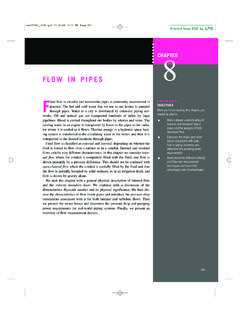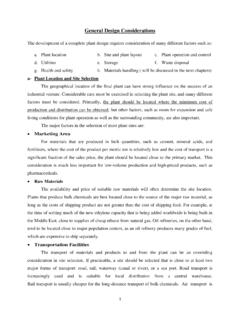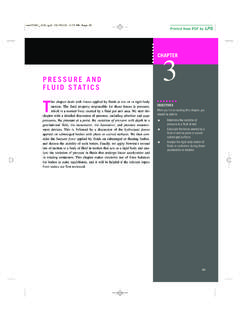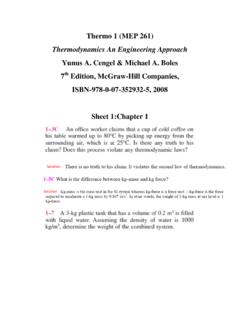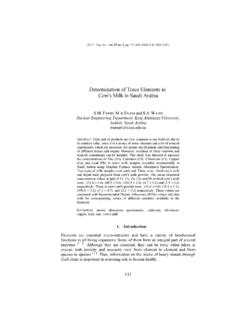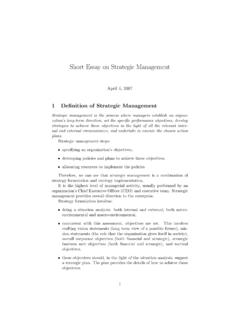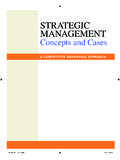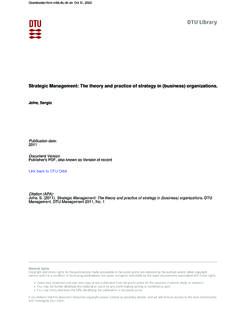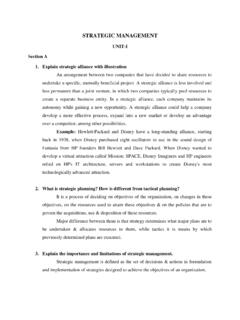Transcription of Neil Ritson - kau
1 Download free ebooks at Neil RitsonStrategic ManagementDownload free ebooks at strategic ManagementStrategic management 2011 Neil Ritson & Ventus Publishing ApSISBN 978-87-7681-417-5 Download free ebooks at click the advert4 strategic ManagementContents1 Introduction 72 The Basis of Strategy: Structure Introduction definition Structure is the allocation and control of work tasks Functional Structure Divisional structure Product structure Geographical structure Matrix structure Complex forms of organisation 143 The Levels and Formulation of Strategy Introduction - definition Process of strategy Levels of strategy Types of Strategy Other Types of strategic formulation 224 Schools of Strategy Introduction - Definition - there are three schools of strategy 24 Designed for high-achieving graduates across all disciplines.
2 London Business School s Masters in management provides specific and tangible foundations for a successful career in business. This 12-month, full-time programme is a business qualification with impact. In 2010, our MiM employment rate was 95% within 3 months of graduation*; the majority of graduates choosing to work in consulting or financial services. As well as a renowned qualification from a world-class business school, you also gain access to the School s network of more than 34,000 global alumni a community that offers support and opportunities throughout your more information visit , email or give us a call on +44 (0)
3 20 7000 in ManagementThe next step for top-performing graduates* Figures taken from London Business School s Masters in management 2010 employment reportDownload free ebooks at click the advert5 strategic The planning school The positional school The resource based school Key points 255 Stakeholder Theory Introduction definition of Stakeholders Explanation External stakeholders 286 External Analysis Introduction Definition: External Analysis Explanation 307 Internal Analysis Introduction and Definition of The Value Chain Explanation Definition: margin Examples: The Human resource audit Culture: 37 Agilent Technologies, Inc.
4 1-800-829-4444 canada: 1-877-894-4414 Teach with the Best. Learn with the offers a wide variety of affordable, industry-leading electronic test equipment as well as knowledge-rich, on-line resources for professors and have 100 s of comprehensive web-based teaching tools, lab experiments, application notes, brochures, DVDs/ CDs, posters, and what Agilent can do for free ebooks at click the advertStrategic Management6 8 SWOT Analysis Introduction SWOT Analysis -definition Explanation 419 Generic Strategy Introduction: Definition Explanation Key Points 4710 Strategy Implementation Contingency view Managing change Lewin s (1951) Force Field analysis 50 References 51 Get StartedGo to for more infoGet a higher markon your courseassignment!
5 Get feedback & advice from experts in your subject area. Find out how to improve the quality of your work!Download free ebooks at Management7 1 Introduction1 IntroductionThis compendium provides a comprehensive overview of the most important topics covered in a strategy course at the Bachelor, Master or MBA level. The intention is to supplement renowned strategy textbooks such as Johnson and compendium is designed such that it follows the structure of a typical strategy this compendium theory is supplemented with examples and free ebooks at Management8 2 The Basis of Strategy: Structure2 The Basis of Strategy: Introduction definition Structure is the allocation and control of work tasksThis implies power relationships based on the acceptance of managerial power by subordinates and society this use of power is termed the legitimacy of management which Max Weber called its authority.
6 All organisations have some form of structure, based on the established pattern of relationships among the individuals, groups and departments within it There are two structures -- a vertical structure of authority and responsibility where clear limits of financial authority exist, and a horizontal structure of groupings of activities designed to use the resources towards horizontal structure can be changed from time to time, to suit the environment (see later sections on the internal and external environments).The basic vertical structure of an organisation is a relatively static framework within which processes such as communication, leadership and decision-making take most organizations, structure will be illustrated in the form of a Functional Structure This is the most common form of structure.
7 This divides the organisation up into its main activities or functions (production, sales, accounting and so on) in which all similar specialist activities are grouped together into interdependent departments. A manager is placed in charge of each function under the overall control of the owner or a senior manager. Advantages of a functional structure Specialised resources are used efficiently. Quality is enhanced by other specialists from the same functional area. Opportunities exist for extensive division of labour. A career structure enables people to advance within their functional specialism. It is easier to manage specialists if they are grouped together, especially when the manager has the same experience.
8 It fosters communication between specialists and enhances the development of skill and knowledge. It does not duplicate specialist resources throughout the organisation and promotes economies of scale. It is suited to conditions which stress functional specialism, where the environment is stable, and when the technology is routine, requiring little interdependence between free ebooks at click the advertStrategic Management9 2 The Basis of Strategy: StructureMarketing directorProduction directorPersonnel managerManaging directorBoard of directorsShareholdersFinance directorR & DdirectorFinancial accounting directorManagement accounting departmentDistribution department managerMaintenance department managerAssembly department managerMachine department managerFigure Functional structureFree online MagazinesClick here to free ebooks at Management10 2 The Basis of Strategy: Disadvantages of a functional structure Increased need for interdepartmental co-ordination and , co-ordination overload the vertical hierarchy.
9 Inefficient co-ordination of functional departments. Responsibility for overall outcomes is unclear. Interdepartmental conflicts. Little creativity and innovation. Difficulties in identifying profitable and unprofitable problems are likely to occur with professionalism and a role culture where job demarcations are felt to be important. When the organisation reaches a certain size, they are likely to be exacerbated especially if it has developed a wide range of products or services. Burns and Stalker (1961) devised the term mechanistic for firms where the interconnections are strong as they are unsuited to changeable environments and non-routine technologies.
10 A more flexible and responsive form is needed than the rigidly functional by adopting a holding company or a divisional structure in which profit centres based on particular products or geographical areas are Divisional structureA divisional structure (see Figure on the next page) can help to overcome the limitations of the holding company and/or a functional structure, as it contains within it functional specialists but groups its activities around products or geographical regions. These two ways of grouping activities are supposed to ensure a closeness to the customer which is not really possible in a functional Advantages of divisionalisation It provides excellent co-ordination across functional departments.
